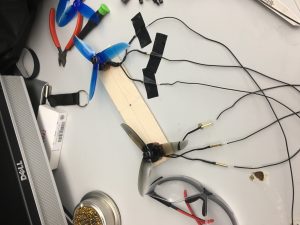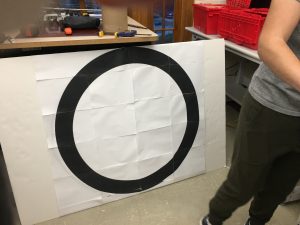This week we improved on the drop test from last week, the problem was that the device spun during most of the descent and the parachute ropes twisted together. To fix this, we shortened the ropes and mounted them on opposite sides of the top. This solution would ensure that the parachutes were separated during the whole drop. Spinning would otherwise interfere with our perception method, which ultimately determines the relative angular position between the device and the target. When we tested this version on Monday there was no noticeable spinning.
We then shifted our focus on movement from our propulsion system. We wanted to see how far the propeller at full thrust would move the device. Wednesday was more appropriate for the lateral distance test, because it was not windy. By this time, another set of parachutes had arrived, so we added a third parachute to the body, so the drop time would be longer. The test showed an additional parachute did not achieve this. We would like to test this a few more times before we reject this option, especially because there is more weight that needs to be added, including the payload and extra propulsion.
At full thrust, the device could not move three meters laterally, a key technical requirement of our project. We decided that each arm of our device should have two propellers instead of one. We already had an extra motor, ESC, and propellers, so we put double propellers on one of the arms. We plan to test the new thrust capability on Monday, and decide whether to order more parts.

Meanwhile, we conducted a few tests on the circle detection code. We found the 1m diameter circle (pictured below) was detected between 48 feet and 10 feet of distance. It is approximately the same indoors and outdoors. We plan to find the angular range of detection at a few fixed distances next week.

